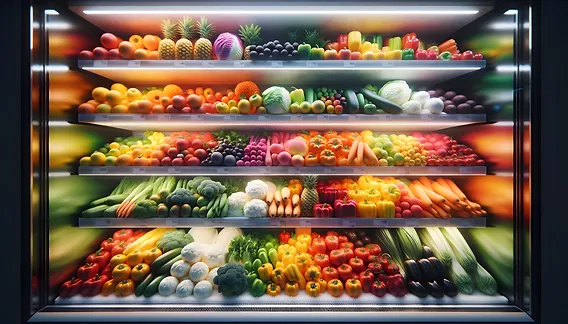When it comes to preserving food, beverages, or perishable goods, your refrigeration system plays a critical role in maintaining freshness and preventing waste. Whether you’re a homeowner aiming to keep groceries fresh for your family or a business owner relying on cold storage to maintain product quality and comply with safety standards, choosing the right refrigeration system is essential.
Identify Your Specific Refrigeration Needs
Before you even start looking at products, you need to assess your specific needs. Ask yourself the following questions:
- How much space do I need? Determine the volume of items you need to store. For smaller households, a standard fridge may suffice, while larger families or businesses require something more spacious.
- How energy-efficient do I want the system to be? Energy efficiency isn’t only better for the environment—it can also save you money in the long run.
- Where will the refrigerator be placed? Measure the area where your fridge will go to ensure the unit fits properly.
- What’s the primary purpose? Is it for residential use, restaurant-grade food storage, or a commercial application?
Identifying your needs will narrow down your options and make the decision process smoother.
Understand the Different Types of Refrigeration Systems
Not all refrigeration systems are created equal, and each type serves a unique purpose. Here’s a quick overview of the common options:
- Top-Mount Refrigerators
These have the freezer compartment located at the top. They’re affordable, available, and great for general household use.
- Bottom-Mount Refrigerators
The freezer compartment is at the bottom, making the fridge section easier to access. They’re perfect for people who want used items at eye level.
- French Door Refrigerators
A stylish and high-capacity option with side-by-side doors for the fridge and a bottom freezer drawer. It’s ideal for modern kitchens and large families.
- Side-by-Side Refrigerators
These have two vertical compartments, one for the fridge and one for the freezer. They’re a good choice for narrow spaces.
- Walk-In Coolers (Commercial Use)
Designed for businesses like restaurants or grocery stores, these large systems provide ample storage for perishable goods. If you’re looking for a reliable commercial refrigeration install in Hawaii, we’ve got you covered.
Each of these systems has its pros and cons, your ideal choice depends on your requirements and space limitations.
Key Factors to Consider When Choosing a Refrigeration System
Now that you know your options, it’s time to focus on what matters most:
- Your Budget
Always start with a budget in mind to avoid overspending. It’s important to not only factor in the purchase price but also consider potential maintenance costs and energy consumption over time.
- Available Space
Measure carefully! A fridge that’s too large for your assigned space can become an inconvenient and costly headache. Ensure there’s enough room for the refrigerator to fit comfortably, including extra clearance for the doors to open.
- Energy Efficiency
Look for models with an ENERGY STAR certification. These models are designed to use less energy, which can cut down your electricity bills and minimize your carbon footprint.
- Technology and Features
Modern refrigerators come with a variety of innovative features, such as smart connectivity, frost-free technology, or adjustable shelving. While these add-ons can improve convenience, make sure they align with your core needs before opting for pricier models.
Tips for Making Your Refrigerator Energy Efficient
- Set the Right Temperature: Keeping your refrigerator set between 35-38°F (2-3°C) ensures it runs efficiently while keeping food fresh.
- Keep the Door Closed: Frequent opening and closing of the door forces the unit to work harder.
- Clean the Coils Regularly: Dust and dirt on the condenser coils reduce the efficiency of the refrigeration system.
- Avoid Overloading: Overloading can obstruct airflow, making the fridge work harder to cool.
- Use Energy-Saving Modes: If your unit has an energy-saving or vacation mode, use it when you don’t need full cooling power.
Small changes can make a big difference in reducing energy consumption and increasing the lifespan of your system.
Purchase and Installation Tips
Where to Buy
When purchasing a refrigerator, stick to reputable retailers with good reviews. Popular options include local appliance stores and well-known online platforms. Ensure the seller offers a solid return policy and warranty.
Professional Installation is Key
For your refrigeration system to function optimally, professional installation is critical. A poorly installed fridge can lead to inefficiency and breakdowns. Many retailers offer installation services as part of the package, or you can hire a trusted professional.
Maintenance Matters
Once installed, regular maintenance can prevent costly repairs. Schedule annual check-ups, and handle any minor issues promptly to avoid larger problems down the line.
Why Choosing the Right Refrigeration System Matters
Selecting the perfect refrigeration system goes beyond convenience—it can have a significant impact on your daily life and even your health. From keeping your groceries fresher longer to ensuring your commercial goods meet safety standards, the right system is an investment worth making.
A carefully chosen refrigeration system will:
- Save you money on energy and maintenance costs.
- Improve the efficiency of your home or business operations.
- Enhance the overall aesthetic of your kitchen or workspace.
Conclusion
Finding the perfect refrigeration system doesn’t have to be overwhelming. By prioritizing your needs and considering factors like budget, space, and features, you can identify the ideal option to simplify your life and boost efficiency.










